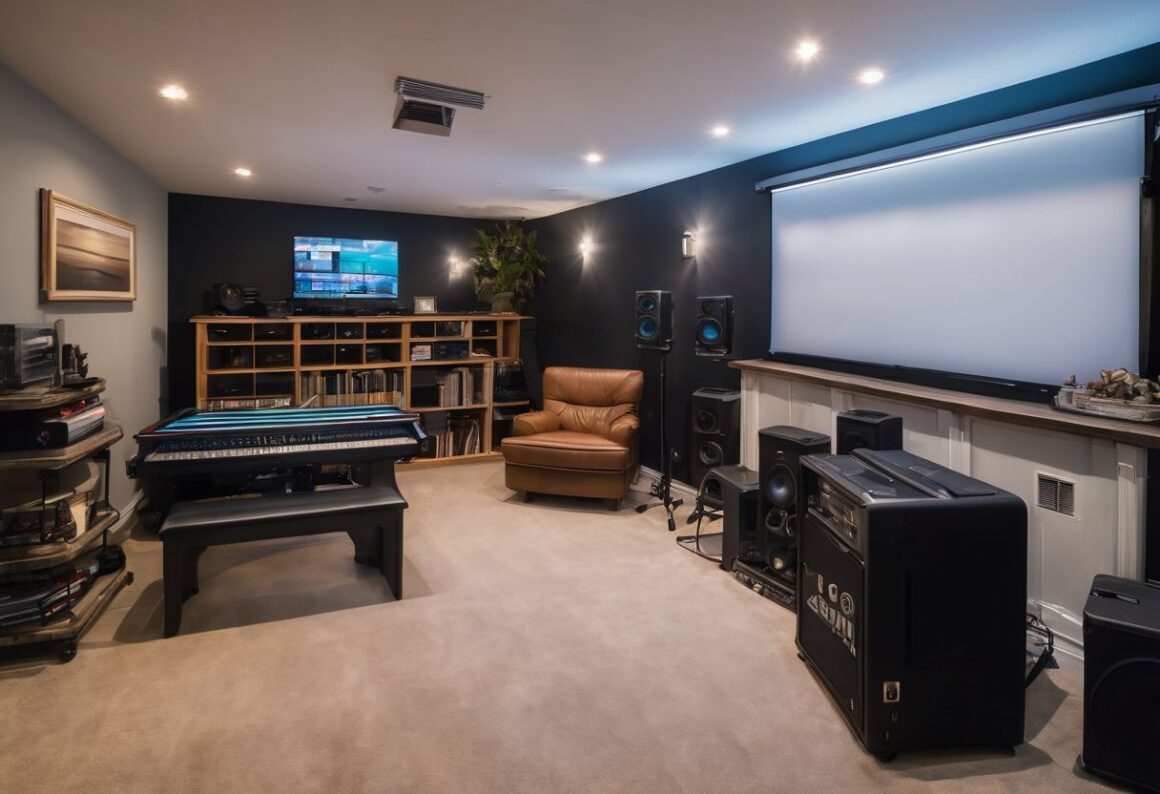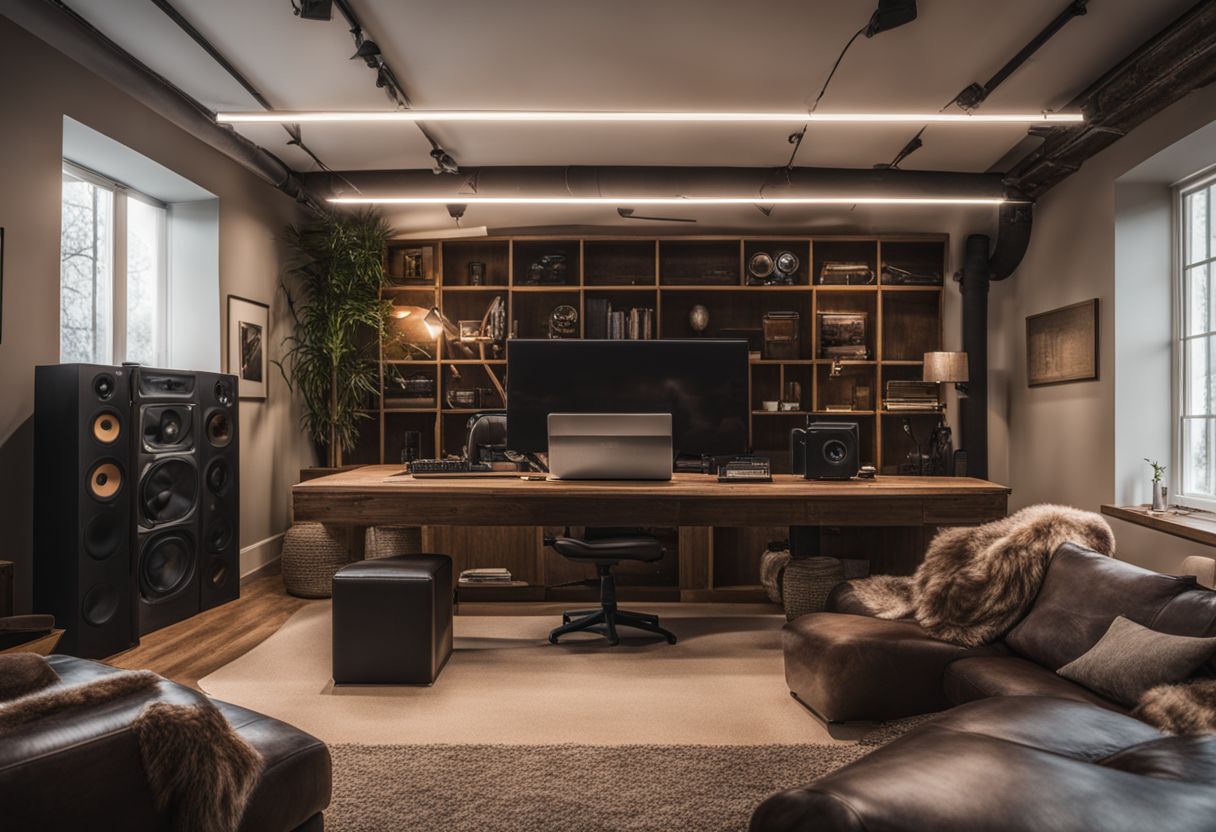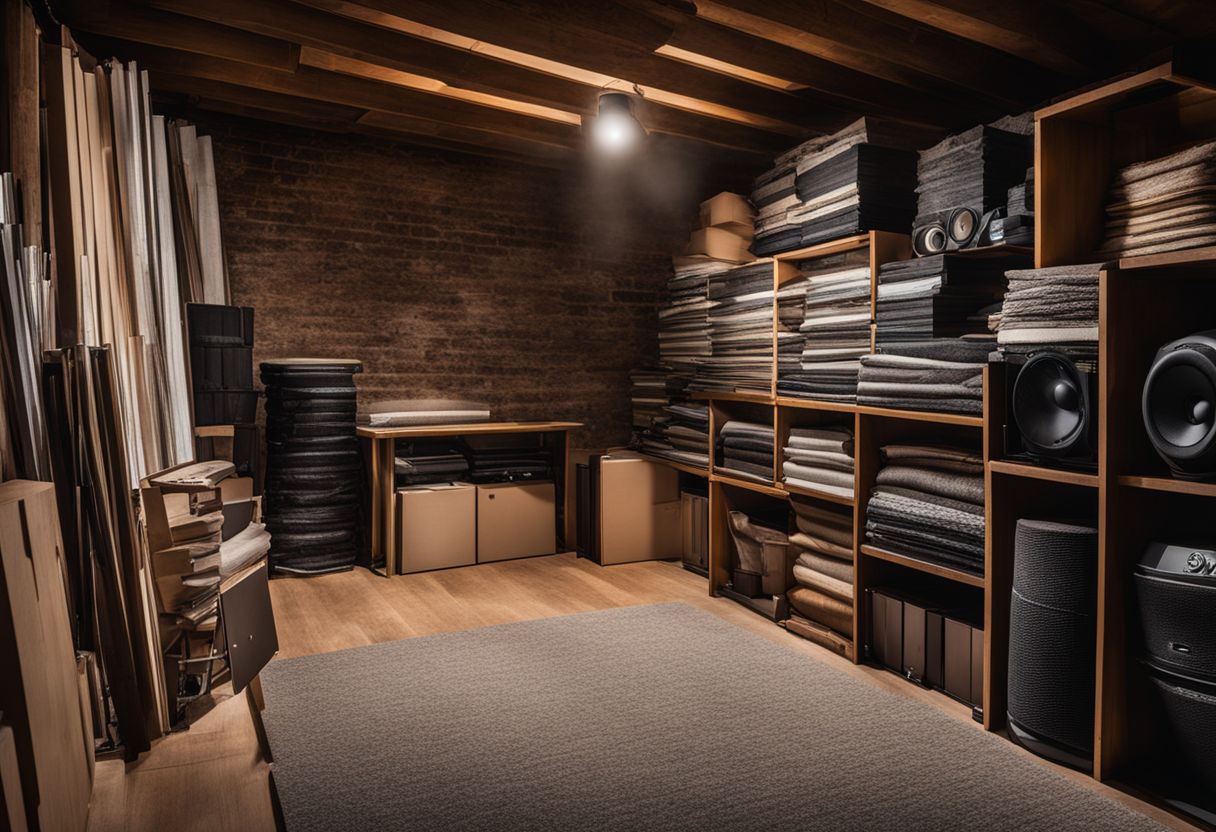Echoing footfalls, booming music, and clattering machinery can turn your basement into a noisy nuisance. Green Glue is just one secret weapon in the battle against basement racket.
This article is packed with simple, effective ways to muffle sound and create a peaceful space below your feet. Stay tuned for some quiet magic!
Understanding Soundproofing Basics
Before diving into the nuts and bolts of making your basement a quiet retreat, it’s crucial to grasp the fundamentals of soundproofing. Learn how noises permeate spaces and what elements play pivotal roles in muffling unwanted sounds effectively.
What is soundproofing?
Soundproofing stops noise from moving through surfaces like walls, floors, and ceilings. It makes spaces quieter by reducing vibrations that carry sound. In a basement ceiling, the right soundproofing can block noise coming in or out.
This is really useful for home theaters or living areas below other rooms.
Good soundproofing uses materials and techniques to control noise. It’s essential for keeping sounds inside a space or stopping outside noise from getting in. For basements used as offices, apartments, or hangouts, effective soundproofing creates a calm environment free from disruptions caused by footsteps or voices above.
How sound travels
Sound travels in waves. These waves move through the air and hit walls and ceilings. When they hit these surfaces, the energy from the wave turns into vibrations. These vibrations pass through solid materials like wood joists and drywall in your basement ceiling.
Vibrations are key to understanding sound movement. If you tap a wall or stomp on a floor, you create vibrations. They spread out to other parts of the room or even beyond that space.
That’s how noise can travel from your basement to upstairs rooms or outside your house. Soundproofing aims to slow down these vibrations, making them weaker so they don’t carry sound as well.
Factors to consider when soundproofing
Before soundproofing your basement ceiling, think about the following factors. They will guide you to make the right choices.
- The type of noise: Understand if the noise is airborne, like music and talking, or impact noise, such as footsteps or objects dropping.
- The current state of your basement: An unfinished basement will require a different approach compared with a finished one.
- Your budget: Plan how much you can spend because materials and methods vary in price.
- Soundproofing effectiveness: Look for products that can block, absorb, and isolate sound effectively.
- Ceiling structure: Take note of whether you have drop ceilings or exposed joists as it will affect installation methods.
- Local building codes: Check these to ensure compliance, especially with fire safety regulations regarding insulation materials.
- Future plans for space: Decide if you need temporary or permanent solutions based on whether you’ll change the space later.
- Installation process: Consider if you want to do it yourself (DIY) or hire professionals. This decision impacts cost and quality.
- Material thickness and density: Thick and dense materials tend to block sound better but may reduce ceiling height.
- Accessibility needs: Think about leaving access to electrical wiring or plumbing by choosing suitable soundproofing methods.
Choosing the Right Soundproofing Materials
Selecting optimal materials is crucial when aiming to muffle noise in your basement ceiling; each product plays a specific role in barricading against sound intrusion. Dive deeper into the array of options available to achieve an environment where peace and quiet reign supreme.
Fire code drywall
Fire code drywall is a tough player in basement soundproofing. Choose 5/8″ sheets for your ceiling to block noise and add safety. This type of gypsum board, known as Type X, holds up better against fire.
It’s not just about quiet; it’s peace of mind too.
Installing this drywall can make a big difference in keeping sounds out. You’ll enjoy a quieter space without breaking the bank. Since it’s thicker than regular drywall, you get more sound-blocking power per square inch.
Use these affordable sheets to upgrade your basement ceiling and cut down on noise from above.
Green Glue soundproofing compound
Green Glue soundproofing compound works wonders for your basement ceiling. It’s a damping product that you spread between sheets of drywall. This magic goo helps stop noise from traveling through walls and ceilings.
When you apply Green Glue, it changes hard vibrations into soft heat energy. That means less sound can pass through to bother you upstairs.
Using Green Glue is one of the best ways to soundproof an unfinished basement ceiling or even if your basement is finished. People love it because it’s not too pricey and simple to use on your own.
You don’t need fancy tools either – just a caulk gun will do! Just squeeze out the compound, press another layer of drywall on top, and boom, sounds stay in the basement where they belong! Plus, this stuff can slash noise by up to 90%.
So whether you’re jamming on your guitar or watching loud movies late at night, Green Glue keeps the peace in the rest of your house.
Fiberglass or mineral wool insulation
Fiberglass insulation is good at soaking up sound. It’s stiff and fits snugly between your basement ceiling joists. But mineral wool insulation does an even better job. Made from real wool, it keeps out noise and helps control the temperature too.
Choosing between them depends on your project needs. Mineral wool has a higher STC rating, around 45. This means it blocks sound a bit better than fiberglass. Cost, health factors, and how well they absorb sound will guide your decision for your basement ceiling soundproofing project.
Metal hat channel and sound isolation clips
Metal hat channels and sound isolation clips create a space between your basement ceiling and the floor above. This space stops sound waves from traveling through solid materials. Sound isolation clips attach to the joists without touching the drywall.
The channels fit into these clips, forming a bridge for new drywall. Sounds hit the drywall and die off before reaching the structure.
These tools work together to keep noise away from your peaceful basement. They are a huge part of making your basement quiet. Use them with other products like Green Glue for even better results.
You’ll enjoy a quieter room where you can relax, play or work without upstairs noise bothering you.
Acoustical caulking
Acoustical caulking seals the gaps in your basement ceiling. It helps stop noise from sneaking through cracks and openings. Unlike regular caulk, acoustic caulk stays flexible and blocks sound better.
Use it along edges where walls meet the ceiling or around fixtures.
For added soundproofing, apply acoustical caulking between two layers of drywall on your basement ceiling. This trick makes it harder for sound waves to pass through, cutting down on noise coming into your space.
Soundproof a basement effectively by using this simple tool; it can make a big difference in your project’s success.
Effective Soundproofing Techniques for Basement Ceilings
Transform your basement into a serene retreat by mastering effective soundproofing techniques that tackle noise head-on. Discover methods to mitigate the transfer of sound and turn your lower level into the peaceful space you’ve envisioned.
Adding mass
To soundproof your basement ceiling, you need to add mass. This means putting more material between the noise and the room above. Mass loaded vinyl is great for this job. You can layer it right onto your basement ceiling to block out sound.
Another way to add mass is by installing gypsum plaster or drywall sheets. They are heavy and good at stopping sound from passing through. If you put up a new layer of drywall, make sure it doesn’t touch the joists directly.
Use metal channels and clips for this part so that sounds don’t travel along solid structures and into the spaces where you want peace and quiet.
Decoupling surfaces
Decoupling surfaces helps stop noise from passing through your basement ceiling. It creates a space between the ceiling and floor joists, breaking up the path sound waves travel on.
You can use resilient channel or isolation clips for this job. They work by keeping walls and ceilings apart.
Install these decouplers carefully along the framing before adding drywall. This method is key to reducing noise that vibrates through solid materials like wood and metal. Decouple effectively and you make a big difference in how quiet your basement becomes.
Damping vibrations
Damping vibrations is key to soundproofing your basement ceiling. Adding mass with materials like drywall or acoustic panels absorbs the energy from sounds. This stops noise from bouncing around and getting louder.
Batt insulation is another great choice for cutting down on sound vibration. It also helps keep the noise level lower by soaking up the vibrations.
Use special compounds like Green Glue between layers of drywall to dampen vibrations even more. The compound makes a soft layer that catches sound waves and turns them into heat, which doesn’t make noise.
This way, you block out unwanted sounds coming from upstairs or outside noises entering your peaceful basement space.
Sealing gaps
Sealing gaps in your basement ceiling can block unwanted noise. Acoustical caulk is a great tool for this job. It’s not expensive and it works well to stop airborne sounds from sneaking through.
Put this special caulk around the edges of your ceiling, where walls meet the ceiling, and in any visible cracks or holes.
For even better soundproofing, use a rubbery compound along with acoustical caulk. This combo fills seams between drywall sheets on your basement ceiling. Take time to inspect the subfloor above too.
Seal any gaps there to keep more sound from getting down into your basement space. Start sealing with acoustic caulk today for an easy way to improve how quiet your basement is!
Absorbing and diffusing sound
Use dense fiberglass or rock wool in your basement ceiling. These materials are great for soaking up sound. They help stop noise from bouncing around and getting louder. You can also put acoustic panels right onto the ceiling to cut down on noise.
This way, sounds don’t echo as much in your basement.
Make sure you know the difference between soundproofing and absorbing materials for a quieter basement. Pick materials that have lots of mass and density, like heavy insulation, to trap more sound.
This helps keep your basement peaceful by not letting sounds spill out or into other rooms.
Budget-Friendly Soundproofing Solutions for Basement Ceilings
Transform your basement into a serene retreat without breaking the bank by exploring cost-effective soundproofing tactics. Discover accessible methods to enhance noise control that both improve your space and preserve your budget.
Adding affordable mass
Adding mass is key to soundproof a basement ceiling. You can use materials like mass loaded vinyl to block noise from above. This heavy substance works great for keeping sounds out of your basement.
It’s easy to install and adds the right amount of weight without too much cost.
Layer sheets of mass loaded vinyl onto your existing ceiling for an extra barrier against noise. Make sure to cover the whole area for the best sound reduction. This step alone can make a big difference in how quiet your basement feels.
With this affordable option, you don’t need a big budget to start soundproofing your space today!
Using acoustical caulking
Seal every crack and gap in your basement ceiling with acoustical caulking. This special caulk stays flexible to stop sound from squeezing through tiny spaces. It’s a cheap tool for better soundproofing.
You just squeeze it into the openings where walls meet the ceiling or around pipes and wires.
Acoustic caulk works great alongside other materials like drywall and insulation. Use it before you add more layers to make sure no noise leaks out. With Green Glue, which is another type of acoustical sealant, you can fill those seams between sheets on the ceiling too.
Remember, these small steps make a big difference in keeping your basement quiet.
Choosing quality products
Look for mass loaded vinyl and acoustic panels to beef up your soundproof basement. These materials help stop noise from passing through walls and ceilings. They are perfect for making a basement music room quieter.
High-density insulation can block out sounds too. It’s heavy, so it keeps noises from bouncing around.
Make sure you buy the best products like fire code drywall and Green Glue. This will make your DIY soundproofing work well. The right stuff will keep your basement quiet and peaceful.
Use high-quality items to cut down on noise in all parts of your home, including the basement ceiling. Soundproofing with good materials is key to enjoy a hush in the lower level of your house.
Conclusion: Tips for Successfully Soundproofing Your Basement Ceiling
Ready to reduce noise and transform your basement into a story within your home? Follow these steps and choose the right materials for your basement ceiling. Remember, adding mass and sealing gaps make a big difference. Soundproofing doesn’t have to break the bank either – smart choices lead to quiet spaces.
Get started and enjoy a peaceful basement today!
FAQs
1. What are soundproofing products I can use for my basement ceiling?
Use mass-loaded vinyl, acoustic foam panels, and drywall to add mass to the ceiling and reduce noise from entering the basement.
2. Is there a best way to soundproof my basement?
Yes! Adding a layer of drywall is one of many ways to soundproof your basement by blocking gaps in the ceiling where sound can travel.
3. Do I need special tools to install a soundproof basement ceiling?
You’ll need basic tools like a drill, screws, and sealant when looking to soundproof your basement walls or ceiling by installing drywall or other materials.
4. Can I still hear noise if I add soundproofing to my unfinished basement?
Soundproofing reduces but may not completely stop all sounds; however, great soundproofing can make your basement quieter by preventing most noises from leaking through.
5. How do I know which type of product will work best for me?
First learn about different types of products that help with noise reduction before choosing what’s far the best match for practical DIY jobs in areas of your home like your basement rooms.
6. When is it time to consider hiring someone instead of doing it myself?
If you find adding mass directly to the ceiling or using strategies like installing a new layer over your first layer of drywall challenging, consider hiring an expert for this job.

Alina Lee, a 35-year-old writer and horticulture enthusiast, brings nine years of expertise to the world of gardening writing. Her journey began with a solid foundation in agriculture, having graduated from Kansas State University in Manhattan, Kansas, with a degree in Agronomy. Alina’s academic background provides her with a unique perspective and a deep understanding of the intricacies involved in cultivating and nurturing plants.
With a passion for greenery and a commitment to sharing her knowledge, Alina has emerged as a prominent figure in the gardening community. Her articles not only reflect a wealth of experience but also a genuine love for the subject matter. Currently serving as a Senior Editor at Home and Around Blog, Alina plays a pivotal role in shaping content related to gardening and outdoor living.
Alina’s writing transcends mere information; it is a blend of practical advice, scientific insights, and a touch of inspiration for both novice and seasoned gardeners. Her commitment to fostering a deeper connection between individuals and nature is evident in her work. As a Senior Editor, Alina Lee continues to influence and inspire readers, contributing to the ever-evolving landscape of gardening literature with her extensive knowledge and passion for plant life.



